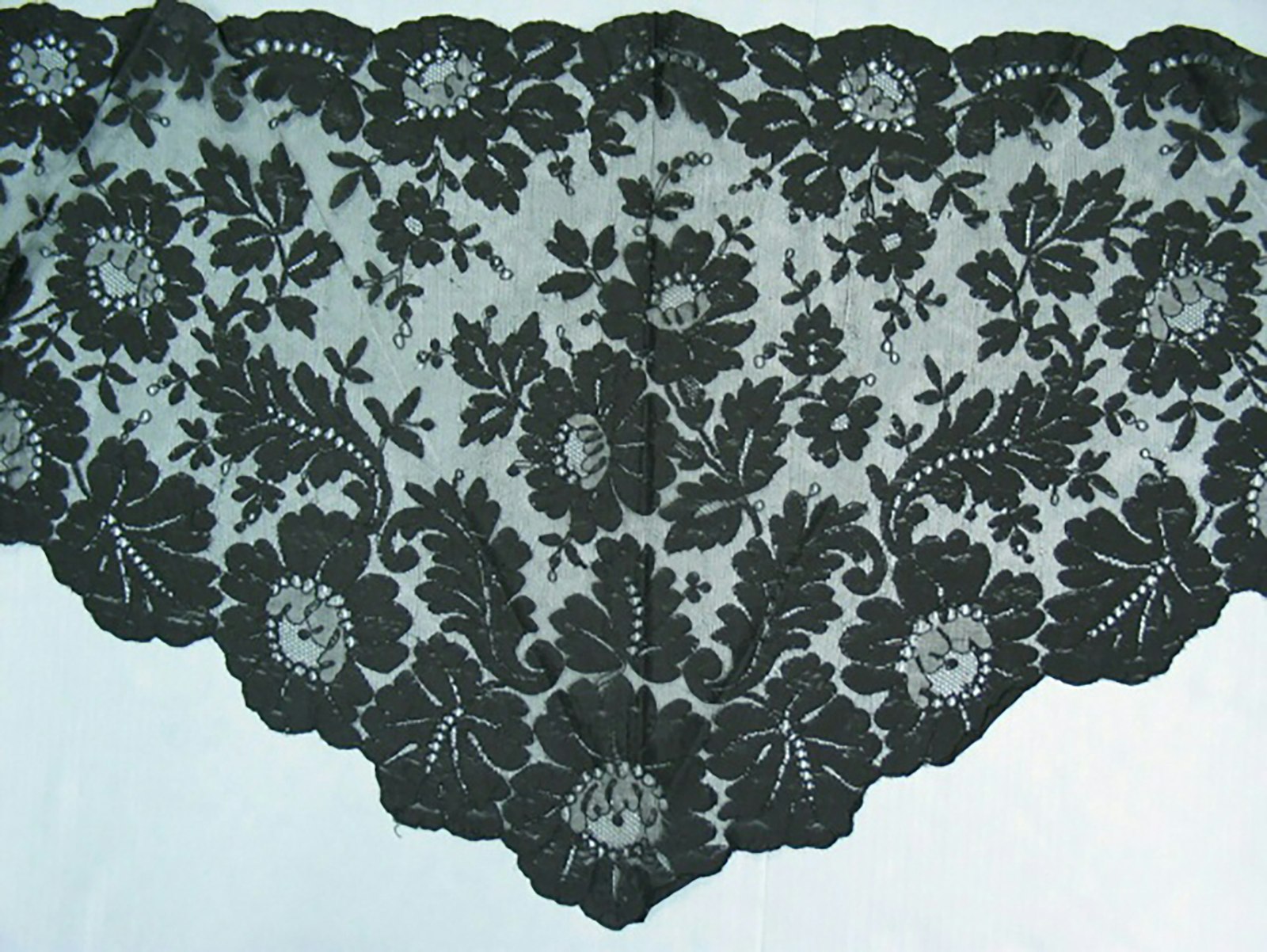In the May/June 2018 issue of PieceWork, our 11th-annual Lace Issue, Mary Polityka Bush tells us about the long tradition of Spanish women wearing a lace mantilla during Holy Week, the period of religious devotion between Palm Sunday and Easter. A woman’s lace mantilla is a very special piece of apparel. Here’s Mary to tell us more:
A Spanish woman’s mantilla is as much a part of who she is as the color of her eyes. Although sumptuary laws may have controlled who could own and wear a mantilla over the years, they also protected the garment. In fact, current law has deemed the mantilla so precious and such a deeply personal possession that it cannot be taken from the woman who owns it, even as payment for a debt. It is unsurprising that mantillas are cherished heirlooms passed from one generation to the next.
 Square mantilla of black Chantilly lace with a cross in the center and a design of floral swags forming a deeply scalloped inner border; bunches of flowers are placed within each scallop. Gift of Mrs. George Nichols from the collection of her mother, Mrs. J.P. Morgan. Courtesy of Cooper Hewitt, Smithsonian Design Museum
Square mantilla of black Chantilly lace with a cross in the center and a design of floral swags forming a deeply scalloped inner border; bunches of flowers are placed within each scallop. Gift of Mrs. George Nichols from the collection of her mother, Mrs. J.P. Morgan. Courtesy of Cooper Hewitt, Smithsonian Design Museum
The mantilla’s beauty is clearly undisputed, but its lineage is less certain. Because it was worn to veil the face early on, some posit a connection to a Muslim woman’s hijab or izār (veil or head covering), an influence that would connect it with the Moorish occupation of the Iberian Peninsula (711–1479). Others contend that today’s mantilla represents a natural progression from the cape or shawl once worn over the head for warmth. Because the word “mantilla” is a diminutive form of manta (blanket), manto (cloak), or manton (shawl), this logic may have merit. The textiles for such mantillas would have varied from heavy, warm fabrics such as flannel, wool, and velvet in the colder north to light, gauzy fabrics (sometimes embroidered to make head coverings called tocas) and eventually lace in the warm southern climes.
 Silk mantilla from the Brooklyn Museum Costume Collection at The Metropolitan Museum of Art, Gift of the Brooklyn Museum, 2009; Gift of Charlotte R. Stillman, 1951. Courtesy of the Metropolitan Museum of Art
Silk mantilla from the Brooklyn Museum Costume Collection at The Metropolitan Museum of Art, Gift of the Brooklyn Museum, 2009; Gift of Charlotte R. Stillman, 1951. Courtesy of the Metropolitan Museum of Art
To read the rest of Mary’s article, “The Lace Mantilla: A Centuries-Old Spanish Tradition,” download your copy of the May/June 2018 issue of PieceWork.
Also, remember that if you are an active subscriber to PieceWork magazine, you have unlimited access to previous issues, including May/June 2018. See our help center for the step-by-step process on how to access them.
Mary Polityka Bush of Piedmont, California, fondly recalls her Polish mother, Jean Polityka, who was a devout Catholic all her life, wearing an ethereal black mantilla to Sunday Mass. The mantilla was a rectangle of delicate embroidered black net that fell past her shoulders. It was the expert handwork of nuns in a convent in Puerto Rico, where it was purchased by a family friend who transported it home to Allegan, Michigan, as a surprise for Mom. She was overwhelmed.
Originally posted April 18, 2018; updated January 17, 2019; updated July 4, 2022.

